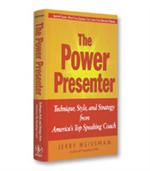
Why did I choose this resource?
Kevin chose this book for me to help with my anxiety when I speak in public and to improve my presenting skills.
What did you learn from it?
I learned how to control my fear of being the center focus in a room. I also learned how to deliver a moving presentation by organizing and taking control of my content, being aware of my body language and tone of voice, and using visual aids to enhance my presentation.
Key Knowledge
- When presenting you transmit human dynamics: Verbal (the story), Vocal (your voice), and Visual (your body language).
- The audience is affected most by Visual, then Vocal, and least of all Verbal.
- The presenter and the audience also share feeling, also known as empathy.
- Reason behind nerves when standing in front of a crowd comes from the Fight-or-Flight reaction. All organisms have this, but humans can bend this to their advantage.
- Anxiety begins to build from the moment a presentation or speech is given a day and time. To avoid the pressure, take action and prepare. Do not wait until the last moment.
- The Seven Steps of story development:
- Define Objective – what is the call to action
- Brainstorm – organize ideas into main themes
- Roman Column – used as a mnemonic device to organize the main themes in your head, usually about 5-6
- Flow Structure – either chronological (time line) or numerical (count down your Roman Columns)
- Graphics
- Ownership – Make the presentation yours, watch over it
- Verbalization – Always practice the presentation as if you were presenting at that moment.
- Anyone can become an expert presenter. It is not something you either have or do not have.
- The Mental Method
- Use concentration to control your mind.
- Focus on your audience, not yourself.
- Present as if you were having a person-to-person conversation
- Make eye contact, use your body to express yourself, emphasize words with your voice, and interact with the audience.
- Cadence or rhythm in your speech is extremely important. Always speak lucidly so the audience can follow and understand you.
- Complete the Arc – While maintaining eye contact, drop your voice at the end of a sentence or phrase to convey that it is a statement and not a phrase.
- Multiple ways of presenting have been used by great speakers in the past.
- Speak from high, inviting your audience to come up and join you
- Speak to the audience at their level
- When using visual aid, present with it. Also known as Graphic Synchronization.
- Maintain eye contact or turn to the visual aid and become a voice over narrator.
How are you using what you learned?
I am using this new information to help me conquer the anxiety I feel when all eyes are on me. This is done by going through all the physical and mental actions of a presentation as if it was for the big show. Practice makes perfect.
Key Changes / Key Actions
- Prepare and practice all speeches.
- Be aware of body language and tone of voice.
Source
- Name : The Power Presenter
- Author : Jerry Weissman
- Summary.com: Link to Book


